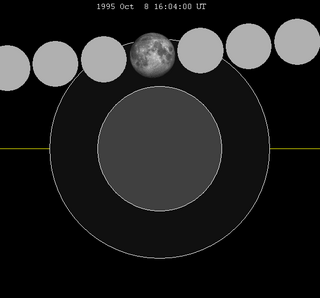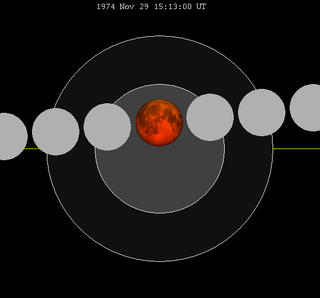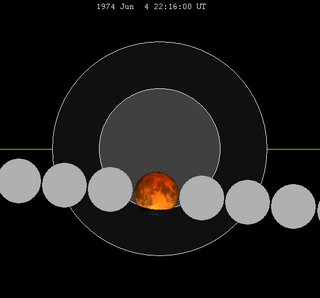
A total lunar eclipse took place on Friday, February 9, 1990, the first of two lunar eclipses in 1990.

A total lunar eclipse took place at 0308 UT (GMT) on Thursday, August 17, 1989, the second of two total lunar eclipses in 1989.

A total lunar eclipse took place on Monday, November 29, 1993, the second of two total lunar eclipses in 1993, the first was on Friday, June 4.

A partial lunar eclipse took place on Wednesday, July 28, 1999, the second of two lunar eclipses in 1999.
A total lunar eclipse took place on Friday, August 6, 1971, the second of two total lunar eclipses in 1971. A dramatic total eclipse lasting 1 hour, 39 minutes and 24.8 seconds plunged the full Moon into deep darkness, as it passed right through the centre of the Earth's umbral shadow. While the visual effect of a total eclipse is variable, the Moon may have been stained a deep orange or red colour at maximum eclipse. This was a great spectacle for everyone who saw it. The partial eclipse lasted for 3 hours, 35 minutes and 31.9 seconds in total. Occurring only 2.2 days before perigee, the Moon's apparent diameter was 3.6% larger than average and the moon passed through the center of the Earth's shadow.

A penumbral lunar eclipse took place on Sunday, October 8, 1995, the second of two lunar eclipses in 1995, the first was a partial lunar eclipse on Saturday, April 15.
A total lunar eclipse took place on Monday, October 28, 1985, the second of two total lunar eclipses in 1985, the first being on May 4, 1985.
A partial lunar eclipse took place on Saturday, August 27, 1988, the second of two lunar eclipses in 1988, the first being on March 3, 1988. The Earth's shadow on the moon was clearly visible in this eclipse, with 29.159% of the Moon in shadow; the partial eclipse lasted for 1 hour, 52 minutes and 59.7 seconds. The Moon was only 5 hours and 48 minutes before perigee, making it 6.3% larger than average

A partial lunar eclipse took place on Monday, June 15, 1992, the first of two lunar eclipses in 1992, the second being with a total lunar eclipse on Wednesday, December 9.
A penumbral lunar eclipse took place on Tuesday, December 20, 1983, the second of two lunar eclipses in 1983. At the maximum eclipse, 89% of the Moon's disk was partially shaded by the Earth, which caused a slight shadow gradient across its disc; this subtle effect may have been visible to careful observers. No part of the Moon was in complete shadow. The eclipse lasted 4 hours and 2 minutes overall.

A total lunar eclipse took place on Friday, November 29, 1974, the second of two lunar eclipses in 1974.

A total lunar eclipse will take place between Sunday, September 7 and Monday, September 8, 2025. The Moon will barely miss the center of the Earth's shadow. It will be the second of two total lunar eclipses. Occurring roughly 3 days before perigee, the Moon will appear larger than usual.
A partial lunar eclipse took place on Sunday, April 12, 1903. This nearly total lunar eclipse of Saros cycle 130 preceded the first total eclipse on April 22, 1921. The Moon was almost covered by the Earth's shadow in a very deep partial eclipse, which lasted 3 hours and 17 minutes. With 96.77% of the Moon in shadow at maximum eclipse, this was quite a memorable event.
A total lunar eclipse took place on Tuesday, November 18, 1975, the second of two total lunar eclipses in 1975. A shallow total eclipse saw the Moon in relative darkness for 40 minutes and 11.1 seconds. The Moon was 6.421% of its diameter into the Earth's umbral shadow, and should have been significantly darkened. The partial eclipse lasted for 3 hours, 29 minutes and 2.1 seconds in total. Occurring only 4.9 days after apogee, the Moon's apparent diameter was 4% smaller than average.

A partial lunar eclipse took place on Tuesday, June 4, 1974, the first of two lunar eclipses in 1974.

A total lunar eclipse took place on Wednesday, October 18, 1967, the second of two total lunar eclipses in 1967, the first being on April 24, 1967.

A total lunar eclipse took place on Sunday, July 26, 1953.

A total lunar eclipse will take place on September 19, 2043.

A total lunar eclipse took place on Friday, October 7, 1949, the second of two lunar eclipses in 1949.

A total lunar eclipse took place on Tuesday, July 16, 1935. It was a central eclipse, passing through the darkest part of the shadow.




































